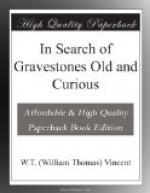The cross and “T.L.” scratched on one of the stones appears to be recent work, and the wonderful preservation of the stone to Lawrence Paine, of 1686, can only be accounted for by the supposition that it has long lain buried, and been lately restored to the light. The stone is of the same perishable kind as the others, and it is certain that it could not have survived exposure to the atmosphere, as its date would imply, for upwards of 200 years. It may even be found that the weather has chipped off the edges of the stones which now appear so jagged, shapeless, and grotesque; but, from recent evidences gathered elsewhere, it is but too probable that these rude pillars have been, and still are, set up as they come from the quarry, without dressing and free from any carving or attention whatever.
Many instances may be found in which slabs of stone, or even slate, have been erected quite recently, the edges untrimmed, and the name of the deceased simply painted upon them more or less inartistically, as in the sketch from Drogheda (Fig. 89). Such crude examples are the more remarkable in a busy and thriving port like Drogheda, and amid many handsome monuments, than among the peasantry of the villages; and it is easy to imagine that if nothing more durable than paint has been employed to immortalize the dead in past times all traces must have speedily disappeared. The illustrations from Drogheda give the whole inscription in each case, neither having date nor age, nor any other particular beyond the name. The memorial on the left hand is of slate—the other two of freestone; and the slate in the northern parts of Ireland is the preferable of the two materials.
[Illustration: Fig. 89. Drogheda.]
There are at Bangor, ten miles west of Belfast, many such slate records, which have endured for more than a century, and are still in excellent preservation. One which attracted my especial notice at Bangor was of the professional character here depicted, and in memory of one of those bold privateers who were permitted to sail the seas on their own account in the old war times.
Fig. 90.—At Bangor, Ireland.
The following is the epitaph, as clearly to be read now as on the day when it was carved on this slab of Irish slate, more than a century since:




